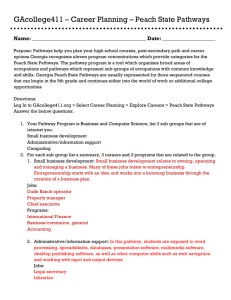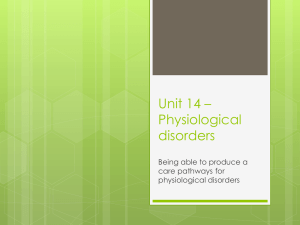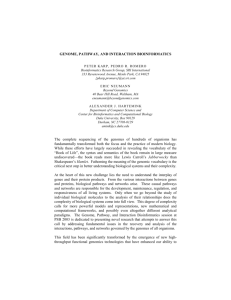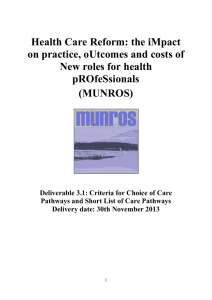Career Pathways - Incentive Funds
advertisement
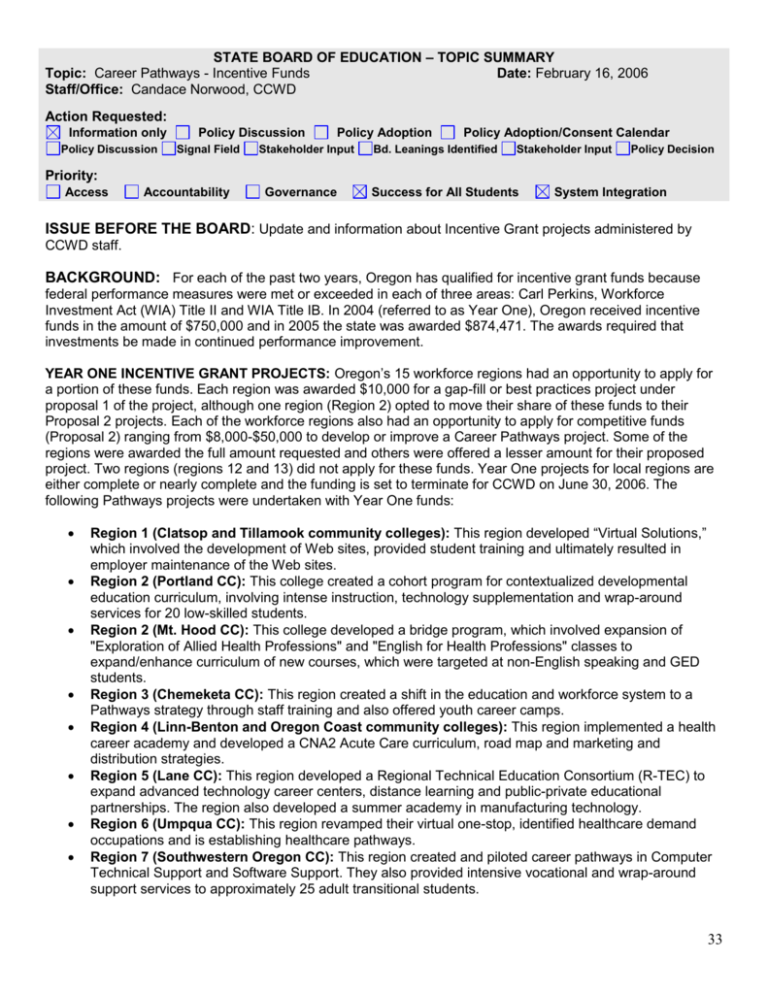
STATE BOARD OF EDUCATION – TOPIC SUMMARY Topic: Career Pathways - Incentive Funds Date: February 16, 2006 Staff/Office: Candace Norwood, CCWD Action Requested: Information only Policy Discussion Policy Discussion Signal Field Policy Adoption Stakeholder Input Policy Adoption/Consent Calendar Bd. Leanings Identified Stakeholder Input Policy Decision Priority: Access Accountability Governance Success for All Students System Integration ISSUE BEFORE THE BOARD: Update and information about Incentive Grant projects administered by CCWD staff. BACKGROUND: For each of the past two years, Oregon has qualified for incentive grant funds because federal performance measures were met or exceeded in each of three areas: Carl Perkins, Workforce Investment Act (WIA) Title II and WIA Title IB. In 2004 (referred to as Year One), Oregon received incentive funds in the amount of $750,000 and in 2005 the state was awarded $874,471. The awards required that investments be made in continued performance improvement. YEAR ONE INCENTIVE GRANT PROJECTS: Oregon’s 15 workforce regions had an opportunity to apply for a portion of these funds. Each region was awarded $10,000 for a gap-fill or best practices project under proposal 1 of the project, although one region (Region 2) opted to move their share of these funds to their Proposal 2 projects. Each of the workforce regions also had an opportunity to apply for competitive funds (Proposal 2) ranging from $8,000-$50,000 to develop or improve a Career Pathways project. Some of the regions were awarded the full amount requested and others were offered a lesser amount for their proposed project. Two regions (regions 12 and 13) did not apply for these funds. Year One projects for local regions are either complete or nearly complete and the funding is set to terminate for CCWD on June 30, 2006. The following Pathways projects were undertaken with Year One funds: Region 1 (Clatsop and Tillamook community colleges): This region developed “Virtual Solutions,” which involved the development of Web sites, provided student training and ultimately resulted in employer maintenance of the Web sites. Region 2 (Portland CC): This college created a cohort program for contextualized developmental education curriculum, involving intense instruction, technology supplementation and wrap-around services for 20 low-skilled students. Region 2 (Mt. Hood CC): This college developed a bridge program, which involved expansion of "Exploration of Allied Health Professions" and "English for Health Professions" classes to expand/enhance curriculum of new courses, which were targeted at non-English speaking and GED students. Region 3 (Chemeketa CC): This region created a shift in the education and workforce system to a Pathways strategy through staff training and also offered youth career camps. Region 4 (Linn-Benton and Oregon Coast community colleges): This region implemented a health career academy and developed a CNA2 Acute Care curriculum, road map and marketing and distribution strategies. Region 5 (Lane CC): This region developed a Regional Technical Education Consortium (R-TEC) to expand advanced technology career centers, distance learning and public-private educational partnerships. The region also developed a summer academy in manufacturing technology. Region 6 (Umpqua CC): This region revamped their virtual one-stop, identified healthcare demand occupations and is establishing healthcare pathways. Region 7 (Southwestern Oregon CC): This region created and piloted career pathways in Computer Technical Support and Software Support. They also provided intensive vocational and wrap-around support services to approximately 25 adult transitional students. 33 Region 8 (Rogue CC): This region is creating a career pathway in business technology to assist students in basic skills through certificate and degree completion, beginning with non-native English speakers. A job counselor was available on an additional campus for six hours per week to provide assistance on completing resume writing, application preparation and interviewing skills development. Region 9 (Columbia Gorge CC): This region worked to increase awareness of health occupation opportunities; to increase participation of minorities, underserved people and high school students; to develop a Certified Nursing Assistant (CNA) 2 curriculum; to increase access to health occupation learning tools; and to promote distance learning. Region 10 (Central Oregon CC)1: This region developed a career pathway in automotive technology in Jefferson County, targeting new speakers of English. Computer study room hours were also increased in order to address ABE gaps. Region 11 (Klamath CC): This region developed a high school-to-journeyman carpenter pilot program and providing workforce ethics training. Regions 12 and 13 (Blue Mt. CC): These regions equipped their one-stops with distance learning capability. Region 14 (Treasure Valley CC): This region developed career pathways that link high school offerings, community college programs and certificate programs. They are developing a Pathways Web site, materials, and curriculum, conducted a Pro-Tech Day and worked to stabilize dual enrollment and community college offerings. Region 15 (Clackamas CC): This region created a CNA program designed for non-traditional populations as an entry point on a healthcare career pathway. Year One funds also provided for CCWD staff support of the governor’s Pathways to Advancement initiative and for the development of a Pathways Web site: www.worksourceoregon.org/pathways. Attached is an example of material developed with Year One funds. YEAR TWO INCENTIVE GRANT PROJECTS: Oregon’s 15 workforce regions had an opportunity to apply for a portion of these funds, which were committed to Pathways to Advancement efforts. Some of the regions were awarded the full amount requested, $75,000, and others were offered a lesser amount for their proposed project, with the lowest funded region awarded $37,500. One region did not receive funding for their proposal and one region did not apply for these funds. An increased focus was placed on the need to share resources, build on existing efforts (within the region or elsewhere), to ensure replicability and to plan for the work undertaken to be sustainable at the completion of the projects. Year Two projects are underway and will continue until January 31, 2007. Funding is set to terminate for CCWD on June 30, 2007. The following Pathways projects were undertaken with Year Two funds: 1 Region 1 (Clatsop, Tillamook community colleges): This region will work with 20 English Language Learners (ELL) students and will develop pathways in business; health; and hospitality, travel and tourism. Region 2 (Portland CC): This college will work a Developmental Education (DE) cohort to develop management and supervisory development workshops. Region 2 (Mt. Hood CC): This college will continue to refine and develop allied health courses for nonnative English speakers. Region 3 (Chemeketa CC): This region will create a Blueprint for a Pathway and continue the college redesign with a focus on Professional Technical programs. Region 4 (Linn-Benton and Oregon Coast community colleges): This region will conduct an inventory of connectable curriculums between high schools and the community colleges. They will also generate an alignment matrix and pilot the results. Corrected March 15, 2006; originally submitted version was “Oregon Coast CC.” 34 Region 5 (Lane CC): This region continued the work of the RTEC to align efforts around manufacturing by developing roadmaps, aligning curriculum, establishing minimum competencies and prerequisites for technology courses and to expand Lane ESD’s Web site on manufacturing pathways. Region 6 (Umpqua CC): This region will develop and implement an Introduction to the Trades class. Region 7 (Southwestern Oregon CC): This region will develop and implement a pathways awareness, marketing and recruitment plan and will continue to coordinate regional efforts. Region 8 (Rogue CC): This region will complete pathways in retail and office and accounting; coordinate healthcare pathways coursework; and develop a landscaping pathway by filling curriculum gaps, modularizing courses and using distributed learning. Region 9 (Columbia Gorge CC): This region will develop retail/business and pre-engineering pathways, continue health occupational pathway work, assess secondary students, conduct a summer institute for faculty members and will produce a recruitment DVD and informational materials. Region 10 (Oregon Coast CC): This region will restructure their health information technology program to reflect a comprehensive pathway. Region 11 (Klamath CC): This region will continue their high school-to-journeyman carpenter program. Region 14 (Treasure Valley CC): This region will continue dual enrollment development with a focus on alignment between secondary schools and the community college. Region 15 (Clackamas CC): This region will conduct assessments for high school seniors. They will also work to improve linkages between the one-stop and Clackamas CC for more comprehensive basic skills assessments, pathway planning and job search assistance. Year Two funds will continue to provide CCWD staff support for the governor’s Pathways to Advancement initiative and for the further development of a Pathways Web site: www.worksourceoregon.org/pathways. DISCUSSION QUESTIONS: 1. 2. Do board members have any questions about the incentive grant projects? Would board members like additional follow-up reporting? 35 Central Oregon Community College Automotive Technology Career Pathway Salaries based on national estimates Source: Occupational Outlook Handbook Higher Education Master’s degree Bachelor’s degree Associate of Arts/Science (2-year) Small Business Development Automotive Electrical Technician (advanced) Auto Electric I Auto Electric II Auto Electric III Automotive Heating and Air Conditioning Systems Technician Auto Electric I Computerized Engine Controls Automotive Air Conditioning Company Executive Manager Forman/Supervisor Business Owner $0 - $200,000 Work Experience Technician $13.00 - $28.00/hour Automotive Engine Performance Technician Auto Electric I Auto Electric II Computerized English Controls Engine Performance I Engine Performance II Diesel Performance I Auto Electrical Technician (basic) Auto Electric I Automotive Drive Train Technician Manual Drive Trains I Automatic Transmissions I Automotive Engines Technician Automotive Engines Diesel Performance I Work Experience Entry-Level Technician $8.00 - $12.00/hour Undercar Technician Steer and Suspension Automotive Brakes Adult Education Work Experience Intensive GED Prep AND Secondary Skills Improvement Developmental Studies: Math, Reading, Writing AND/OR Basic Skills Improvement English Language Learning Public School High School Career Education Middle School Career Exploration Self-paced Automotive Core Automotive Program Orientation Mechanical System I Basic Electricity for Automotive Small Gas Engines Intensive Work Readiness + Follow-up Workplace Basic Skills (VESL / VABE) Semi-Skilled Jobs Slightly more than minimum wage Work Experience Unskilled Laborer Jobs minimum wage 36


